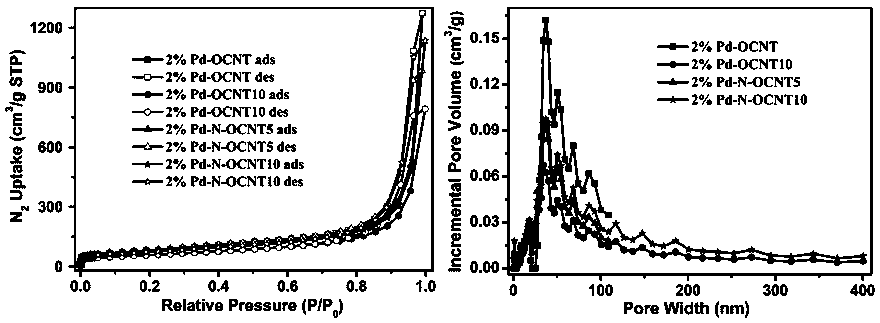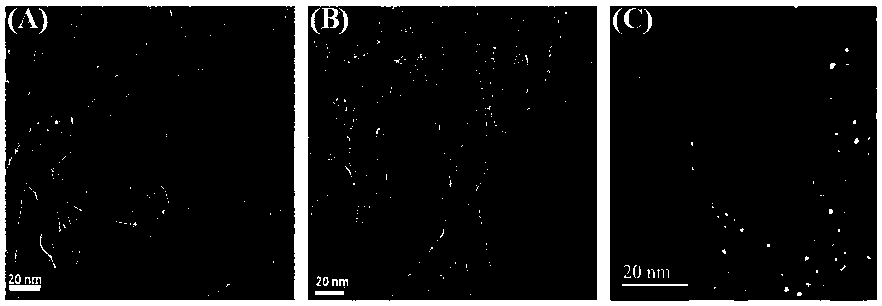Preparation method and application of functional carbon nanotube loaded Pd catalyst
A technology of carbon nanotubes and catalysts, which is applied in the field of preparation of functionalized carbon nanotube-supported Pd catalysts, can solve the problems that carbon-based catalysts have not been reported, and achieve remarkable catalytic oxidation performance, cheap equipment raw materials, and simple operation
- Summary
- Abstract
- Description
- Claims
- Application Information
AI Technical Summary
Problems solved by technology
Method used
Image
Examples
Embodiment 1
[0031] Acidification of carbon nanotubes: Mix 10 g of carbon nanotubes with 400 mL of 68 wt% concentrated nitric acid, reflux at 110 °C for 4 hours, cool to room temperature, wash with distilled water until neutral, dry at 80 °C, and then grind Stored as powder for later use, the sample is marked as OCNT;
[0032] Modified carbon nanotubes: Dissolve 0.08 g of citric acid, add drop by drop to 1 g of OCNT by impregnation, stir until uniform at room temperature, dry and heat in a pre-set blast oven at 180°C for 40 hours ; After cooling down to room temperature, wash with distilled water for 3 times, dry at 80°C and store for later use; the sample is marked as OCNT2;
[0033] Nitrogen-doped modified carbon nanotubes: Dissolve 0.25 g of urea in 10 mL of water, add dropwise to 0.5 g of the above-mentioned modified carbon nanotubes, transfer to the polytetrafluoroethylene liner of the hydrothermal kettle, seal it, and put it in the pre- Set it in a blast oven at 180°C, heat it for 8...
Embodiment 2
[0036] Acidification of carbon nanotubes: Mix 10 g of carbon nanotubes with 400 mL of 68 wt% concentrated nitric acid, reflux at 100 °C for 4 hours, cool to room temperature, wash with distilled water until neutral, dry at 80 °C, and then grind Stored as powder for later use, the sample is marked as OCNT;
[0037] Modified carbon nanotubes: dissolve 0.2 g of citric acid, add dropwise to 1 g of OCNT by impregnation, stir until uniform at room temperature, dry and heat in a pre-set blast oven at 180°C for 40 hours ; After cooling down to room temperature, wash 5 times with distilled water, dry at 80°C and store for later use; the sample is marked as OCNT5;
[0038] Nitrogen-doped modified carbon nanotubes: Dissolve 0.25 g of urea in 10 mL of water, add dropwise to 0.5 g of the above-mentioned modified carbon nanotubes, transfer to the polytetrafluoroethylene liner of the hydrothermal kettle, seal it, and put it in the pre- Set it in a blast oven at 180°C, heat it for 8 hours; a...
Embodiment 3
[0041] Acidification treatment of carbon nanotubes: 10 g carbon nanotubes were mixed with 400 mL of 68 wt% concentrated nitric acid, refluxed at 120 °C for 4 hours, cooled to room temperature, washed with distilled water until neutral, dried at 80 °C, and then ground Stored as powder for later use, the sample is marked as OCNT;
[0042] Modified carbon nanotubes: dissolve 0.4 g of citric acid, add dropwise to 1 g of OCNT by impregnation, stir until uniform at room temperature, dry and heat in a pre-set blast oven at 180°C for 40 hours ; After cooling down to room temperature, wash with distilled water 4 times, dry at 80°C and store for later use; the sample is marked as OCNT10;
[0043] Nitrogen-doped modified carbon nanotubes: Dissolve 0.25 g of urea in 10 mL of water, add dropwise to 0.5 g of the above-mentioned modified carbon nanotubes, transfer to the polytetrafluoroethylene liner of the hydrothermal kettle, seal it, and put it in the pre- Set it in a blast oven at 180°C...
PUM
 Login to View More
Login to View More Abstract
Description
Claims
Application Information
 Login to View More
Login to View More - R&D
- Intellectual Property
- Life Sciences
- Materials
- Tech Scout
- Unparalleled Data Quality
- Higher Quality Content
- 60% Fewer Hallucinations
Browse by: Latest US Patents, China's latest patents, Technical Efficacy Thesaurus, Application Domain, Technology Topic, Popular Technical Reports.
© 2025 PatSnap. All rights reserved.Legal|Privacy policy|Modern Slavery Act Transparency Statement|Sitemap|About US| Contact US: help@patsnap.com



